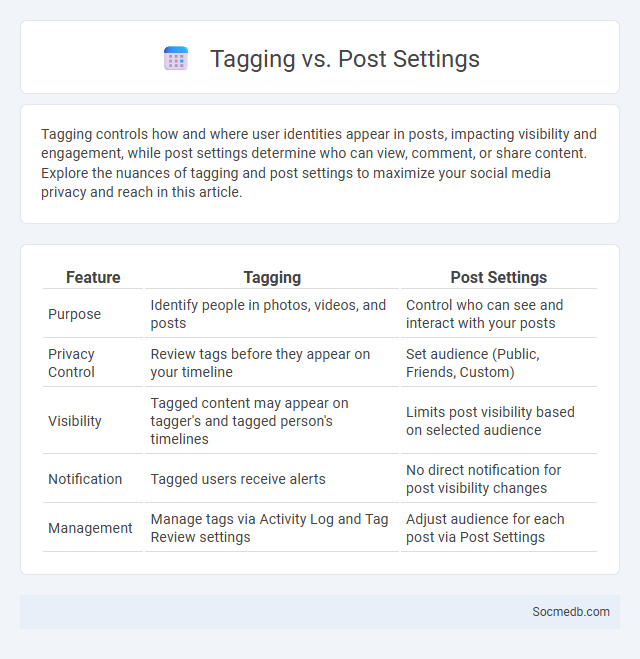
Photo illustration: Tagging vs Post Settings
Tagging controls how and where user identities appear in posts, impacting visibility and engagement, while post settings determine who can view, comment, or share content. Explore the nuances of tagging and post settings to maximize your social media privacy and reach in this article.
Table of Comparison
| Feature | Tagging | Post Settings |
|---|---|---|
| Purpose | Identify people in photos, videos, and posts | Control who can see and interact with your posts |
| Privacy Control | Review tags before they appear on your timeline | Set audience (Public, Friends, Custom) |
| Visibility | Tagged content may appear on tagger's and tagged person's timelines | Limits post visibility based on selected audience |
| Notification | Tagged users receive alerts | No direct notification for post visibility changes |
| Management | Manage tags via Activity Log and Tag Review settings | Adjust audience for each post via Post Settings |
Introduction to Tagging and Post Settings
Tagging on social media enhances content discovery by associating your posts with relevant people, locations, or topics, increasing engagement and reach. Post settings allow you to control privacy, audience selection, and interaction options, ensuring your content is shared with the desired group. Mastering tagging and adjusting post settings empowers you to maximize visibility while maintaining control over your social media presence.
Defining Tagging in Content Management
Tagging in content management involves assigning relevant keywords or labels to social media posts, enabling efficient categorization and retrieval of information. This practice enhances user engagement by improving discoverability and facilitating targeted content recommendations. Effective tagging strategies lead to increased visibility and optimized search engine performance across diverse platforms.
Understanding Post Settings: Key Features
Post settings on social media platforms determine who can view, comment, or share content, enhancing privacy and audience targeting. Key features include visibility options such as public, friends-only, or custom lists, as well as controls for tagging, commenting permissions, and post expiration. Mastery of these settings helps users manage their online presence effectively, ensuring content reaches the intended audience while maintaining security.
Differences Between Tagging and Post Settings
Tagging on social media allows you to identify and link specific users or accounts directly within a post, increasing visibility and engagement by notifying those tagged. Post settings control who can view, comment, or interact with your content, offering privacy and customization options tailored to your audience preferences. Understanding both features enables you to manage your social interactions effectively while maintaining control over your content's reach and engagement.
Use Cases: When to Use Tagging
Tagging on social media enhances content discoverability and strengthens user engagement by connecting relevant profiles or topics directly within posts. It is effective during event promotions, influencer collaborations, or customer shoutouts to amplify reach and foster community interaction. Utilizing tagging strategically helps brands track conversations, monitor campaign performance, and personalize audience experiences.
Use Cases: Best Scenarios for Post Settings
Post settings on social media platforms are crucial for tailoring content visibility to specific audiences, enhancing engagement, and protecting privacy. You can optimize post settings by choosing options like public, friends-only, or custom lists to target your messages effectively, whether promoting a brand, sharing personal updates, or conducting surveys. Advanced settings such as scheduling posts, restricting comments, and tagging permissions help manage interaction and maintain content relevance in dynamic social environments.
Impact on SEO: Tagging vs Post Settings
Tagging on social media significantly enhances your SEO by improving content discoverability through targeted keywords and relevant user mentions. Proper post settings, such as privacy levels and geo-tagging, influence content visibility and search engine indexing, affecting organic reach and engagement metrics. Leveraging both tagging and optimized post settings strategically amplifies online presence and drives higher traffic from search engines to your profiles or websites.
User Experience: Navigability and Organization
Effective social media platforms prioritize navigability and organization by implementing intuitive interfaces that reduce user effort in finding content. Categorized menus, clear icons, and personalized feeds enhance content discovery and streamline interactions, resulting in higher user engagement. Consistent layout design and responsive navigation adapt to various devices, ensuring seamless user experience across smartphones, tablets, and desktops.
Common Mistakes in Using Tagging and Post Settings
Common mistakes in using tagging and post settings on social media include tagging irrelevant or excessive accounts, which can reduce engagement and annoy followers. Users often neglect privacy settings, accidentally sharing posts publicly instead of with a targeted audience, leading to potential security risks. Misconfigured tags and unclear post visibility settings can also hamper content reach and audience interaction.
Best Practices for Efficient Content Management
Effective social media content management relies on strategic planning, consistent scheduling, and audience engagement monitoring to maximize reach and impact. Utilizing analytics tools to track performance metrics enables data-driven decisions and content optimization. Implementing content calendars ensures timely posting and cohesive brand messaging across platforms.
 socmedb.com
socmedb.com